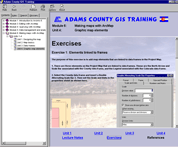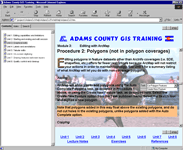|
The Magazine for
Esri Software Users
|
|
|
Use HTML Help to Stretch Your Training Dollars
By Daniel Elroi, GIS Consultant
HTML Help is the emerging standard in help file technology. It is gradually replacing the well-established WinHelp format familiar to most Windows users. What is interesting about HTML Help is that it isn't just for help anymore. Most computer users will readily concede that "nobody reads the stinkin' documentation"--a statement that encompasses help files. This article will not try to change that. Instead, it will explain how this highly capable technology can be put to a variety of exciting uses. A technology looking for an application, as it were-not an unusual concept for the GIS practitioner! Specifically, this article will address the use of HTML Help for GIS training and user support purposes.
What's All the Hoopla About?
Let's begin by describing HTML Help, since many users have not yet used HTML Help. Those who have may not have realized the difference between HTML Help and traditional WinHelp. HTML Help was developed by our friends in Redmond, Washington, to replace the aging WinHelp format. WinHelp has been used extensively over the years. It accompanied almost every Windows-based software program with the exception of the occasional help file in Adobe FrameMaker or Adobe Acrobat. In searching for extraordinary examples of WinHelp projects on the Internet, I was amused to find a WinHelp-based course for passing the Texas Concealed Weapon License exam and a handy interactive guide to the I Ching. However, the format is limited in its cross-platform usability, has some difficulties in interfacing with other software, and is definitely not Web-enabled. Competing vendors such as Macromedia Director have come up with products that overcome some of these shortcomings and provide a more multimedia support for help files.
Microsoft has now created a new HTML-based help format that is intended to be the standard help format for Windows 98, Windows NT, and beyond. Though not as powerful as some of the other proprietary formats mentioned, HTML Help is more generic and open to development. Both WinHelp (.HLP) and HTML Help (.CHM) files are compiled. The life of an HTML Help file begins as one or more HTML files. These files are compiled into a single, compact file that contains all of the files, images, and links contained in the source files.
Viewing a .CHM file requires Microsoft's Internet Explorer 4.x or higher or for the truly Internet Explorer intolerant, at least some of the dynamic linked libraries (DLLs) that come with Internet Explorer. A .CHM file can contain any of the goodies that a normal HTML file can contain such as animated GIFs, JavaScript, Dynamic HTML, and ActiveX components. The user can navigate through hypertext links and can view external Web pages directly in the HTML Help Viewer or in a Web browser. Visit ArcUser Online for links to sites with additional information on HTML Help.
Getting Help with HTML Help
As it did with WinHelp, Microsoft provides a basic compiler and guidelines for creating .CHM files. The HTML Help compiler can be downloaded from the Microsoft Web site at no charge. However, "souped-up" HTML Help editors and compilers, such as RoboHelp HTML from Blue Sky Software and Doc-to-Help Professional from WexTech, are available. These software packages are intended for the user who does not wish to learn HTML or the intricacies of the compiler or for the professional help author who wants all the power tools available. These packages let users decompile traditional WinHelp files and recompile them as HTML Help files. Some packages let the user turn the HTML files and images used to create a .CHM file into a stand-alone Web site, so the contents of an HTML help file can be published directly on an Intranet or the Internet for use with any Web browser on any operating system. These software packages are intended for the user who does not wish to learn HTML or the intricacies of the compiler or for the professional help author who wants all the power tools available. These packages let users decompile traditional WinHelp files and recompile them as HTML Help files. Some packages let the user turn the HTML files and images used to create a .CHM file into a stand-alone Web site, so the contents of an HTML help file can be published directly on an Intranet or the Internet for use with any Web browser on any operating system.
Without giving Microsoft too much credit, HTML Help does serve its purpose quite well. Esri is already using HTML Help. For an example, see the AODev.CHM file in ArcInfo 8. Beyond being a cool new help file format, why does HTML Help warrant an article in ArcUser magazine? To answer that, let's look at some of the things one can do with HTML Help other than write help files. To argue that help files are terribly useful for ensuring that software is used correctly is about as exciting as extolling the virtues of using seat belts. Common sense dictates that help files should be used, yet there are plenty of software users who refuse to touch them and this article can't change that. However, HTML Help can bring some comfort to GIS users.
Training--The Gift That Doesn't Keep on Giving
Remember the saying "The more you learn, the more you know; the more you know, the more you forget; the more you forget, the less you know; therefore, the more you learn, the less you know"? Most GIS managers know, deep in their hearts, that a modest return from their training budget is all they can expect. A week of intensive out-of-town training, begrudgingly approved by a manager, often translates into forgotten lessons and training materials binders collecting dust back at the office. This is not an argument against formal training. Without formal training, GIS professionals would be further behind. However, refinement of the materials used in training can achieve better results. No new software gizmo can guarantee this, but HTML Help can greatly enhance the benefits of training. The program at Adams County, Colorado, provides an example of how this can be done.
Real-World Example
Recently, Adams County commissioned an ArcInfo 8 training course. This course was to be written and delivered in a format tailored to the specific GIS needs of County users. Adams County decided to deliver all training materials in HTML Help format to
- Provide study materials that could be more easily used and reused.
- Provide a format that could be more easily linked to other resources such as existing help files, Web sites, and other miscellaneous files.
- Provide future staff with exactly the same materials used by the lecturer and students during initial training.
- Disseminate training materials over an Intranet for an even wider distribution in the organization.
How Adams County realized these benefits is described below.
What You Get Is What You See
ArcInfo 8 training at Adams County was conducted in a computer training facility. The training lectures were accompanied by computer-projected slides created with HTML Help rather than Corel Presentations or Microsoft PowerPoint. Students received copies of the same HTML Help file used by the lecturer and could follow along on their own screens.
 This HTML Help file could be viewed again at any time by students on their workstations. After the students completed training and returned to work, they had the training file in HTML Help format readily available while they tried their new skills. The advantage of HTML Help files over a set of printed lecture slides is that the materials are always available and are searchable. This HTML Help file could be viewed again at any time by students on their workstations. After the students completed training and returned to work, they had the training file in HTML Help format readily available while they tried their new skills. The advantage of HTML Help files over a set of printed lecture slides is that the materials are always available and are searchable.
This training file contained all the exercise instructions as well as the lecture notes. One software package could be used to create, present, and distribute all training for Adams County. In addition, HTML Help lets help authors create a nicely formatted, printed version of the help file.
Clicking and Surfing the Night Away
The training materials created for Adams County leveraged the power of existing resources in order to provide more for less. Often, the role of a trainer is merely to show students where to find the resources they need to accomplish a task. Helping students help themselves often has a more permanent effect than trying to cram massive amounts of information into a short period of time. The HTML Help file created for Adams County contained many links to specific topics in existing Esri WinHelp files. These links are the help equivalent of telling students to open a reference book to a certain page or an encyclopedia to a certain topic. The HTML Help file was also linked to Adobe Acrobat .PDF files created by Esri. Finally, it also provided direct links to Esri's Web pages and other Web sites. The HTML Help file contained not only the original training materials but also useful links to reference materials that students might not otherwise have known about.
It's Here, It's There, It's Everywhere
Adams County does not currently operate an Intranet. Consequently, the training files were made available over the local area network. This is a very compact and easy way to distribute the information. A .CHM file can be structured to display other .CHM files. One basic .CHM file was distributed and an icon was associated with it on the students' computer desktops. As new modules were created and distributed, the basic file displayed the new modules as new chapters. The students did not have to deal with an ever larger (and therefore slower) single file. Instead, the library of files increased but appeared to be part of a single file. Even the index and search capabilities spanned these files, so that they appeared as a single resource.
In the future, as more GIS users come online at the County, or if the HTML Help file is augmented with content relevant to the general public, these materials can be easily converted to a set of linked HTML files and added to a Web site for viewing using any Web browser. Any loss in performance attributed to using HTML Help will be made up for by its ease of distribution and accessibility.
Conclusion
You can lead a horse to water, but you can't make it read the documentation. Is HTML Help more flexible and powerful than WinHelp? Certainly it is. Can GIS professionals be made to use it? Certainly not, but if they choose to do so, they will be richly rewarded. Okay, that sounds hokey, but how would you end an article on help files?
For more information please contact
Daniel Elroi
Independent GIS Consultant
Denver, Colorado, USA
Tel.: 303-355-4-GIS
Fax: 303-975-5223
E-mail: daniel@elroi.com
Web: www.elroi.com
About the Author
Daniel Elroi is an independent GIS consultant and programmer residing in Denver, Colorado. For the past 13 years he has been implementing GIS systems, consulting, and programming for employers and clients in local, state, and national governments, as well as in the pipeline, oil and gas, mining, and real estate industries. He is a frequent speaker at GIS conferences and specializes in the application side of GIS. Daniel is a native of Israel and a graduate of the University of California, Los Angeles.
| |